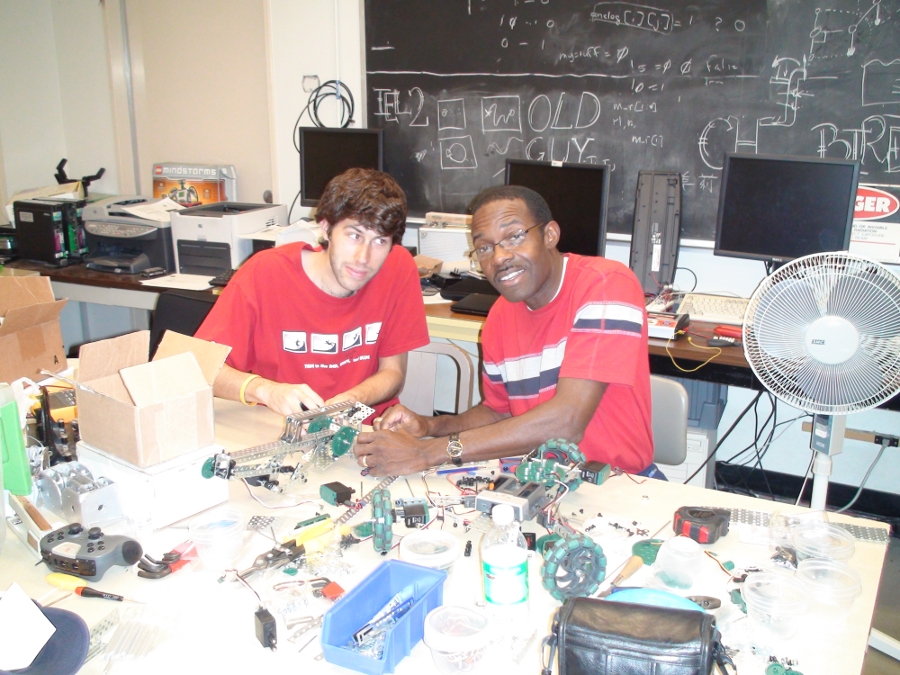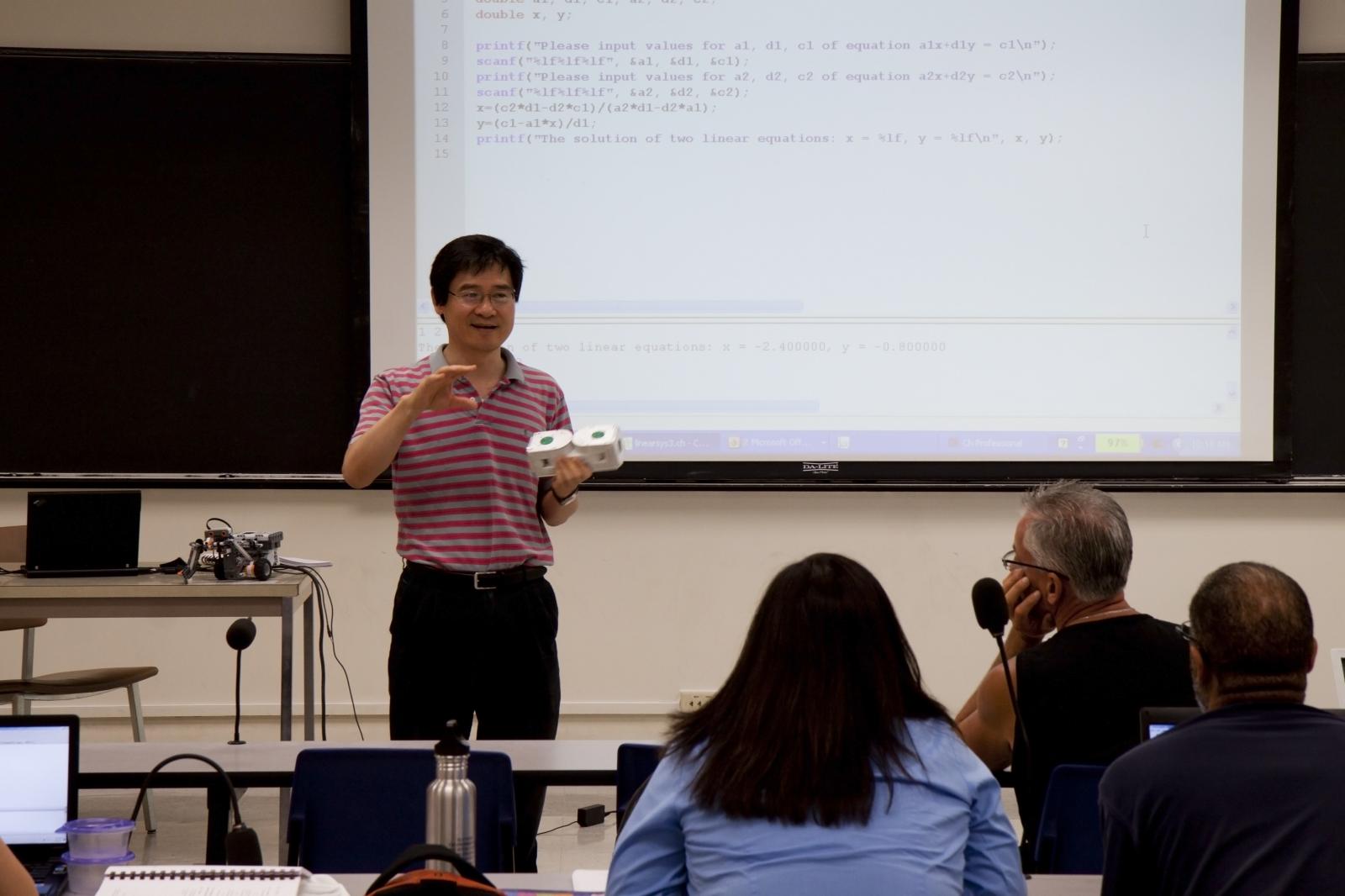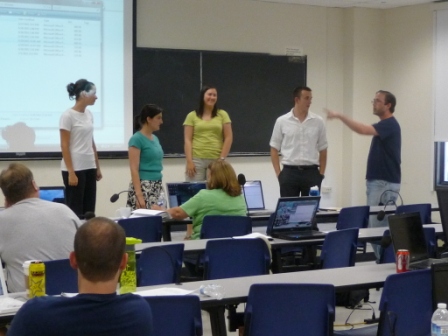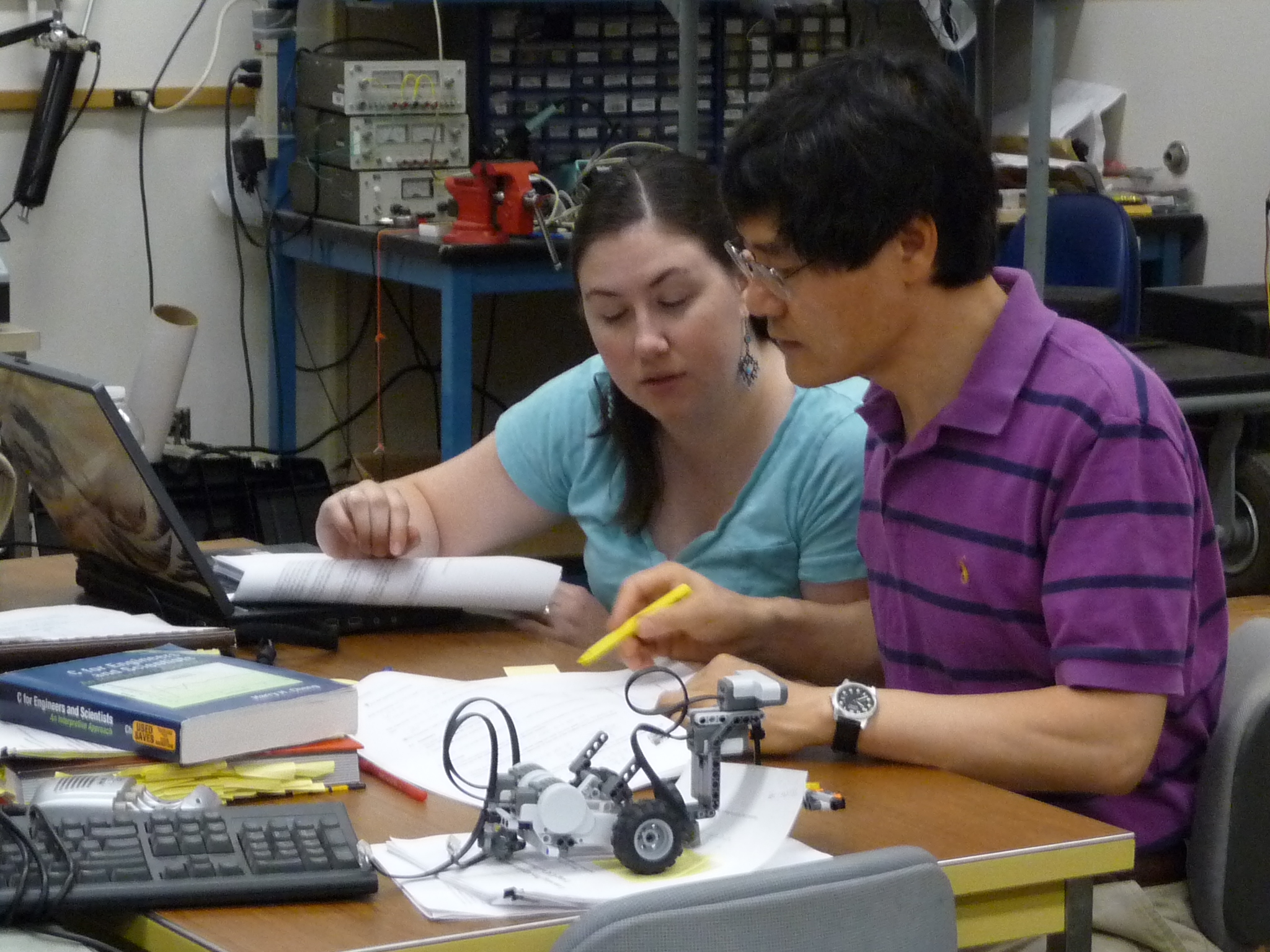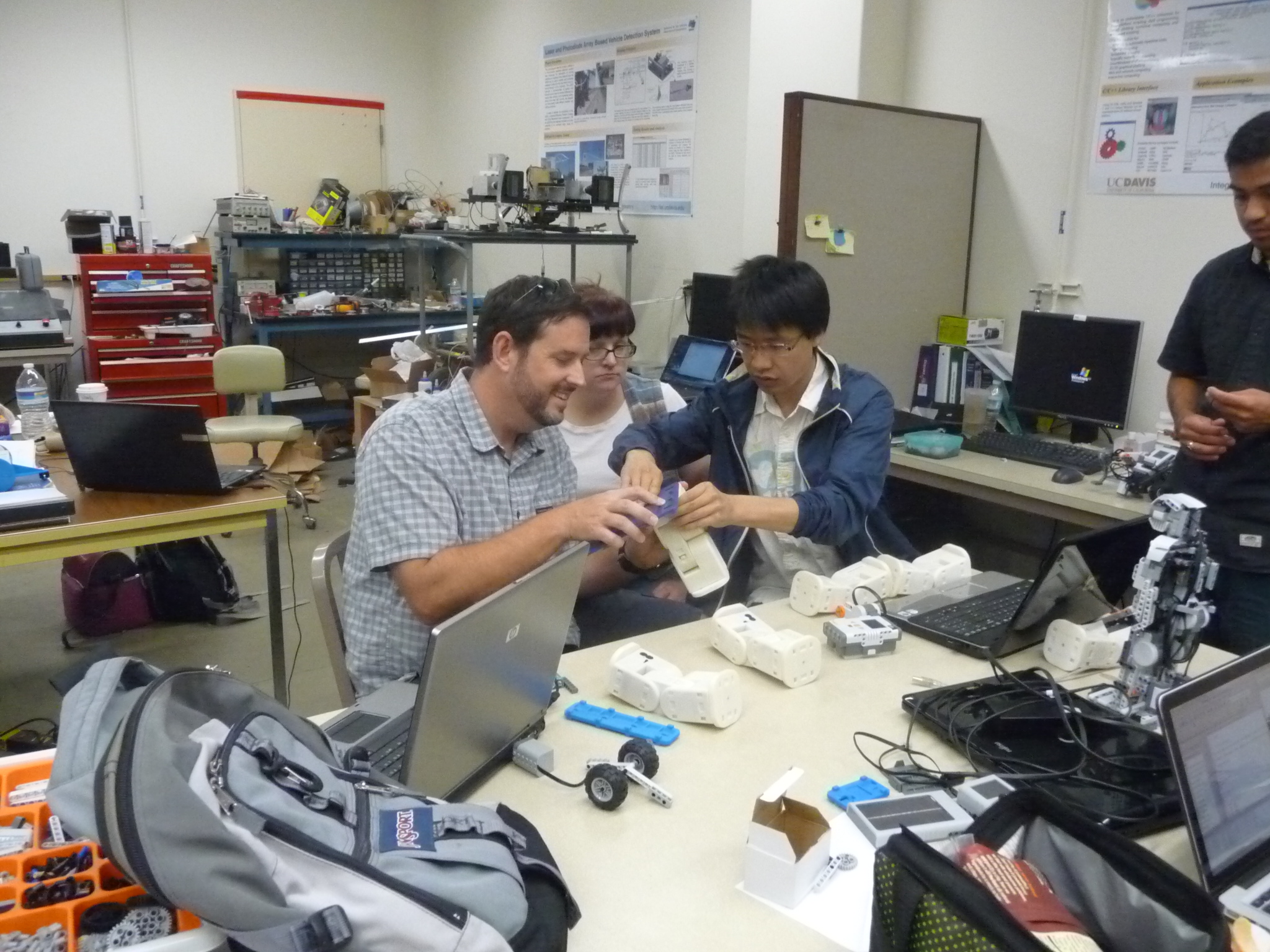CREST
The C-STEM Center conducts the NSF Research Experiences for Teachers (RET) Site project “Computing Research Experiences for STEM Teachers (CREST)” under the Grant CNS1132709 with $500,000 starting with the six-week (8 hours/day) summer program with the academic year follow-up plan.
Deadline for application for 2013-2014 CREST Fellows: April 5, 2013
Notification Date for Accepted Fellows: April 19, 2013
Information Session Date: February 7, 2013, 5pm – 6pm, 2033 Bainer Hall
Information about the 2013-2014 CREST Program can be found in the flier HERE.
“My experience with C-STEM has been far more rewarding than I expected. My principal signed me up for a 2 week training last summer with Professor Cheng at UCD Davis. I was very tentative to attend because I had no background in computer science and did not see how it could be helpful to my middle school students. I was very wrong. I attended the 2 week training and joined for the fellowship to help develop the curriculum. I taught programming as an elective using the C-STEM curriculum this year and was thrilled to see how it positively affected such a wide range of my students. My low students were so motivated by learning how to operate the robots that they improved their understanding of difficult math concepts like rates, proportions, and writing and solving equations. My higher students were excited by the new challenge and all the different possibilities that they devoted extra time to the material outside of school and are now looking up what computer science classes they can take at the High School. This has been a very rewarding experience for my students and I can’t wait to teach it again next year.”
— Megan Schoellhamer, Mathematics Teacher, Bridgeway Island Elementary School
CREST Project Summary
This “Computing Research Experiences for STEM Teachers (CREST)” project will create an enduring partnership between secondary school science, technology, engineering and mathematics (STEM) teachers and UC Davis faculty mentors and C-STEM Center to promote teachers’ professional development and create a teaching “infrastructure” that stimulates and inspires them to effectively guide their students towards computing and STEM related careers and post-secondary study.
Last spring I graduated with my B.S. in Physics and was enrolled in a credential program for the following year. I heard about the CREST Fellowship through the MAST program at UC Davis and found the idea of implementing computer programming skills into secondary education very interesting. Throughout the summer I participated in the 6 week fellowship which had a very profound effect on my future career. Starting the fellowship as a pre-service teacher, I ended with multiple job offers teaching physics in the Sacramento area. Ultimately, the CREST Fellowship helped solidify my career and made me a highly valuable and marketable candidate for a teaching position. I now teach applied physics at the high school level, and engineering at the middle school level at the School of Engineering and Sciences (SES) in Sacramento. The CREST Fellowship made it possible for me to teach directly out of college with only my bachelors degree. In addition to everything already mentioned, I was provided with a years worth of engineering curriculum and modular robots (Mobots) which are an excellent tool for engaging students. My current teaching position was made possible by the skills I learned and the connections I made during the Summer fellowship. I would highly encourage any who is teaching, or is interested in teaching STEM, to consider this fellowship.
— Ryan Mangan, Applied Physics and Engineering Teacher, School of Engineering and Sciences
Forty five in-service and pre-service computer science and STEM teachers (15 per year for 3 years, with 11 in-service teachers and 4 pre-service teachers each year) will participate in the project as CREST Fellows. These CREST Fellows will be trained with computing and computer programming using the C/C++ interpreter Ch for problem solving, paired with faculty mentors to experience cutting-edge research related to computing, and develop curricular materials for the integration of computing in STEM subjects in a six-week summer program. UC Davis faculty mentors and their students will support Fellows to implement research project-based computing and engineering activities in their classrooms during the academic year. Fellows and their students will showcase their accomplishments on the UC Davis C-STEM Day in spring.
Payments for CREST Fellows
The CREST project will pay stipend to CREST Fellows ($4,800 with $160/day for in-service teachers and $3,000 with $100/day for pre-service teachers) during the six-week summer program, additional stipend during the academic year, some materials and supplies such as modular robot Mobot for implementation in classroom and afterschool programs, and some expenses for traveling to present the research results and papers in conferences. Every two students in a Fellow’s class will have a robot from the project.
Research Projects
Faculty mentors in this CREST project are leading computational researchers in their fields who have also devoted significant effort to education at all levels. Fellows’ research will emphasize scientific inquiry and computing for teaching math, computer science, physics, and biology concepts in K-12 schools. Brief descriptions of research projects for Fellow training are detailed below. These projects will provide Fellows with meaningful opportunities to improve their computing and engineering content knowledge, and demonstrate the relevance of computing and engineering concepts to teaching math and science subjects.
More Faculty Mentors will be added in the coming months. Please check back for an up-to-date list before you submit your application.
Professor Angela Cheer:
Numerical Modeling of Complex Biological Systems
Professor Cheer’s research uses mathematical modeling and numerical techniques to probe our understanding of biological problems and elucidate the underlying mechanisms. In particular, she examines how fluids flow in the complex geometries which characterize living systems by using appropriate grids/meshes to track the fluid velocity, pressure, etc at different locations. Applications of her work have impacted the direction of both scientific research and technological development resulting in new ideas, new areas of research and new areas of technological development. In her fish feeding research for example, her work has fundamentally changed the way biologists view the function of biological filters. By solving the fluid dynamical equations coupled with experimental data, they disproved previous theories of how these structures interacted with particles suspended in fluid and proposed a new mechanism for suspension feeding fishes. In the area of medicine, these same techniques can be used to model how dangerous fluid flow patterns develop in human arteries and the human heart, and then how they might be treated medically. CREST Fellows working in the Cheer group will learn the fundamental principles of how fluid flow pattern is treated with computer programs, beginning with how to write numerical simulations for simple situations and equations governing fluid flow patterns.
Professor Harry H. Cheng:
Reconfigurable Modular Robotics
Professor Cheng’s research group develops affordable, reconfigurable, reprogrammable, and autonomous robots for research, education, industrial, law-enforcement, and military applications. Unlike other fixed robotic systems, identical reconfigurable modules with low cost can be used to configure different robotic systems on demand of the tasks. Dr. Cheng’s research group have developed a breakthrough intelligent modular robot called iMobot. A single module is able to have variety motion possibilities. Multiple modules can be used to form different robotic systems such as snake, humanoid, and trunk. Based on the UC patented technology, Barobo, Inc. is a commercial spin-off of iMobot. Recently, the company has been awarded an NSF SBIR Phase I grant to scale up the iMobot lab prototype for commercial deployment. CREST Fellows will work with Dr. Cheng and his research staff to re-design and reshape iMobot so that it will be suitable for K-12 classroom teaching and robotics competition. CREST Fellows will learn how to write C/C++ programs to control iMobot and reconfigured robotic systems and integrate this novel modular robot in their classroom teaching and robotics competition. Fellows will also learn how to integrate entrepreneurship into K-12 education, by teaching students how to design, manufacture, market, and sell a technical product in a knowledge-intensive market.
Professor Chen-Nee Chuah:
Computer Networks and Wireless/Mobile Computing
Prof. Chuah’s research interests lie in the general area of computer networks and wireless/mobile computing, with emphasis on Internet measurements, network management, anomaly detection, online social networks, and intelligent vehicular traffic control. Her approach is driven by analysis of real measurement data from various sources and across different protocol layers. CREST fellows working in the Robust & Ubiquitous Networking (RUBINET) Laboratory during the summer quarter would be involved with analyzing measurement data, OpenFlow prototyping effort, FPGA programming, and simulation studies of vehicular networks and applications. Two main areas of research are involved: 1. Programmable and Adaptive Traffic Measurement Architecture for Autonomic Network Management: Accurate traffic measurement is essential for both network management tasks (e.g., traffic engineering) and security forensics (e.g., detecting attacks). Work here focuses on new dynamic measurement and routing paradigms. 2. Measuring and Modeling the Growth of Online Social Networks and Applications: The viral growth of online social applications can potentially influence how content is produced and consumed in the future Internet. Research in this area focuses on large-scale measurement study of the usage characteristics of on-line social network based applications by launching Facebook applications and the development of dynamic graph models to capture growth patterns.
Professor Cristina Davis:
Chemical and Biological Sensing
Professor Davis’ group conducts research on detection of gas phase chemicals for various applications. Her group creates of new enabling micro- and nanotechnology devices that can be used as fundamental building blocks in our detection systems. Teachers who work on this project will help to develop advanced numerical simulations of microsystem comp onents. Such modeling can inform design choices before device prototyping occurs. Addi tionally, they can work to develop sample acquisition programming of graphical user inte rfaces using LabView, and their programs could ultimately be embedded onto portable fiel d instruments for real-time data collection. Additional work can develop a real-time pa ttern matching interface on the portable instruments to scan incoming data and look for positive “hits” when a new piece of data matches to an established library of chemical signatures we seek to detect.
Professor Michael Delwiche:
Electronic Sensors and Control for Biological Systems
Professor. Delwiche’s research interests are the design and analysis of electronic sensors, instrumentation, and control strategies for biological production systems. Most of his current research projects can be grouped into three areas: (1) precision control of water and fertilizer application, (2) control of vertebrate pests, and (3) bacterial pathogen contamination of fruits and vegetables. These areas combine basic research with clear and important applications to the economy and society, and hence are especially appealing to secondary school students. CREST fellows working in the Bioinstrumentation and Control Laboratory during the summer quarter would be involved with microcontroller programming and field work for the precision irrigation and fertilizer application projects.
Professor Soheil Ghiasi:
Embedded and Programmable Systems
Professor Ghiasi’s research group (LEPS) works on design, analysis and optimization of embedded computing systems, where application-specific digital systems are developed to interface the two digital and physical worlds. Examples include computing systems that are integrated in robots, cars, airplanes, factory control systems, wearable health and wellness applications, and gaming devices. In contrast with general-purpose computers, such systems are expected to serve a relatively small number of applications at real time, with lower energy consumption and comparatively, should be developed at lower costs. Professor Ghiasi has worked on different aspects of embedded system design ranging from novel architectures and applications to compilation techniques and design automation. His group takes special interest in embedded software; and programmable and reconfigurable platforms because they provide system flexibility and customization after fabrication. Programmability is beneficial in developing robust computing systems that can be reconfigured after deployment for reliable and robust operation.
Professor Bahram Ravani:
Robotics for Highway Maintenance
Professor Ravani’s research group tests and evaluates new technologies, and trains students and professionals in transportation operations and technology. One of the primary tasks of his AHMCT Center is to investigate the application of advanced automation and robotics to highway maintenance and construction. During the course of the research, a large number of robotic automation systems, including wheeled mobile robots and telerobots for highway maintenance have been developed. Teachers will work directly with graduate students and research staff at the AHMCT Center to develop robotic automation systems for highway maintenance. They will gain the first-hand experience on how robotics are developed and deployed for highway maintenance. In particular, they will get involved in the mechanical design, hardware and software design, system integration, and field testing of robotic automation systems for highway maintenance.
Professor Richard Scalettar:
Computational Materials Science
Professor Scalettar’s research focuses on using computer simulation programs to understand the properties of materials: Why are they magnetic? What distinguishes a metal from an insulator? When will a solid become a superconductor? While some of these questions involve sophisticated background, many can be addressed with remarkably simple programs which involve concepts and mathematics readily accessible to high school students. In this CREST project, we intent to focus on a method called “molecular dynamics” (MD) which involves elementary notions of velocity and position to move a collection of particles around. Although the programs are not very complex in their structure or mathematical requirements, molecular dynamics is used in research fields not only in materials science but also in biology (protein folding) and cosmology (the formation of galaxies). CREST Fellows will learn to write MD programs in C/C++ using Ch and how these can be used to study properties of materials.
CREST Fellow Application
Deadline for application for 2013-2014 CREST Fellows: April 5, 2013
Notification Date for Accepted Fellows: April 19, 2013
Information Session Date: February 7, 2013, 5pm – 6pm, 2033 Bainer Hall
For the 2013 CREST Fellows, 11 in-service teachers and 4 pre-service teachers will be chosen.
CREST Fellow Commitments
CREST Fellows are expected to fully commit to the following:
- Each Fellow must integrate C-STEM Curricula with computing and modular robots, into his/her regular classroom activities throughout school year in any grade from 6 to 12.
- Fellows are required to attend regular monthly one-and-an-half-hour meetings.
- Project evaluation and reporting are critical components of continued funding of the program. Fellows will complete and deliver assessment instruments and/or participate in interviews as part of project evaluation by the required deadlines.
- Assist in obtaining permission from your school to collect student performance data.
- To measure student progress, Fellows must conduct mandatory student surveys as needed with the support of our external evaluator.
- Fellows are required to fill out and submit bi-monthly reports online to help track progress of teaching of the C-STEM curriculum, which takes about five minutes to complete.
- Fellows are required to attend the UC Davis C-STEM Day with Math Programming Competition and RoboPlay Competition on May 4, 2013.
- Form a Computing and Robotics Club and be a teacher adviser for participation in the following competitions: Secondary School Math Programming Competition and RoboPlay Competitions on the UC Davis C-STEM Day in 2014.
- Fellows are required to attend the UC Davis Annual Conference on Computing and STEM Education on May 18, 2013.
- Have access to a computer lab during the academic year
- Schools or school districts are committed to install necessary software for the project promptly.
- Fellows are required to attend the two-week 2013 UC Davis Summer Institute on Computing and STEM Education on June 24-July 5, 2013
- Willing to attend six full weeks in summer for training and research, including the two-week 2013 UC Davis Summer Institute on Computing and STEM Education on June 24-August 2, 2013
Pre-Service Teachers
A pre-service teacher is a person currently enrolled in the Teaching Credential Program in School of Education and will be continuing through the Fall to get his/her MA degree. If you are in the UC Davis Mathematics and Science Teaching (MAST) Program and has declared your minor in Education, you are also qualified as a pre-service teacher for the CREST Fellow. If you have been accepted into the teaching credential program in June and will start your program in August, you are not qualified as a pre-service teacher for our CREST program starting in June.
The application for the 2013 CREST Fellow for pre-service teachers will include letters of recommendation from advisers, collaborating teachers and/or principals preferably including school plans for integrating computing into STEM education and implementation, as well as the transcript from the student’s university.
In-Service Teachers
An in-service teacher is a person holding a teaching position in K-12 schools. If you have been offered a teaching position in June 2013 and will start in August, you can also apply as an in-service teacher.
The application for the 2013 CREST Fellow for in-service teachers will include letters of recommendation from the principal and/or district coordinator, as well as school plans for integrating computing into STEM education and implementation. To build “critical mass” in a school for innovation on computing and STEM education, we prefer to select two CREST Fellows from the same school.
